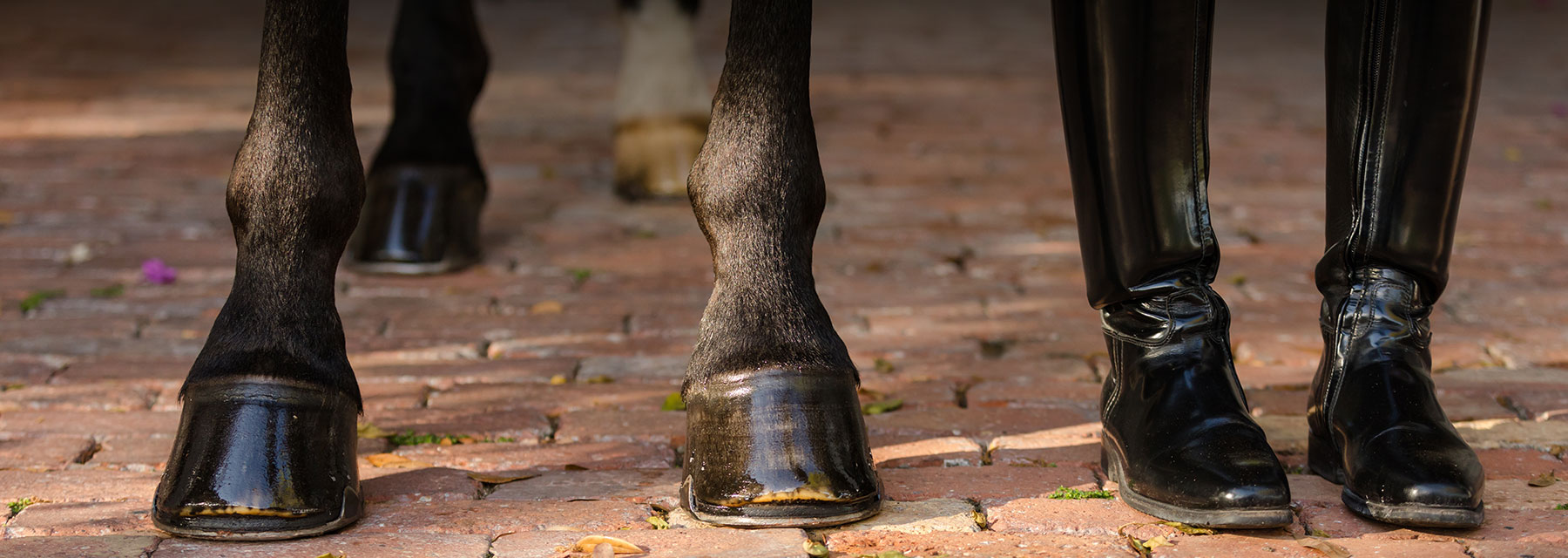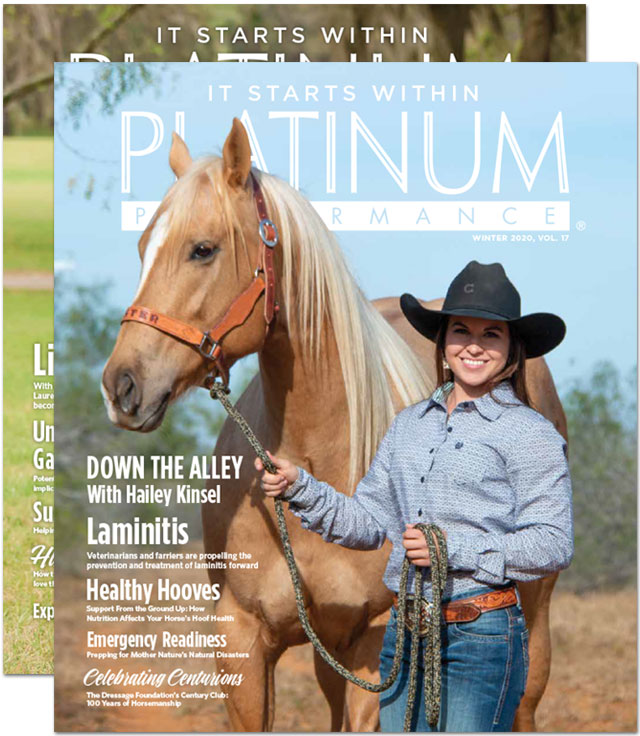Supporting Healthy Hooves Through Nutrition
There is a common phrase in horse lore that rings in the ears of many horsemen pertaining to equine feet: No hoof, no horse. Anyone that has ever dealt with hoof issues knows the truth in this simplistic statement. The foot of the horse is the foundation of the animal. Its well-being affects so many areas of the horse and can even be an indicator of overall health. Genetics may be the most influential factor to good hooves, but other factors like age, breed, metabolic rate, environmental moisture, illness, shoeing and exercise can all have influence on hoof quality as well. Despite these variables, one thing is certain: the quality of the hoof has a definitive nutritional component. Because hoof tissue is relatively fast-growing, similar to hair, any nutritional deficiencies may first be detected by observing changes in the hoof. Dietary changes can positively or negatively affect the hoof’s overall integrity because it is in a continuous state of growth. Horses on well-balanced diets are less likely to have foot problems. A balanced, forage-based diet is essential for all areas of equine health, including hoof health.
5 Dietary Factors For Strong, Healthy Feet
1. Calories
Total energy or caloric intake directly correlates to the growth rate of hooves. Ensuring that a horse is in a positive energy balance means that total intake meets or exceeds output; the horse is maintaining or gaining weight. The diet should provide enough energy to promote growth of the hoof wall while maintaining a healthy body condition. If a horse has very poor-quality hooves, consider total energy intake first. A horse in a negative energy balance will utilize protein to compensate for energy needs for maintenance or growth, etc. This may create a secondary protein or amino acid deficiency that will directly impact hoof quality.
2. Protein and Amino Acids
Protein is the essential foundation of a solid hoof making up over 90% of the hoof wall on a dry weight basis. Protein deficient diets lead to general poor hoof quality as shown by reduced growth and splitting or cracking of the hoof. Hoof tissue contains many amino acids, which are the building blocks of protein, and must be available in appropriate amounts in the diet. Most importantly to hooves are the essential amino acids, lysine and methionine, needed to produce the primary structural protein, keratin.
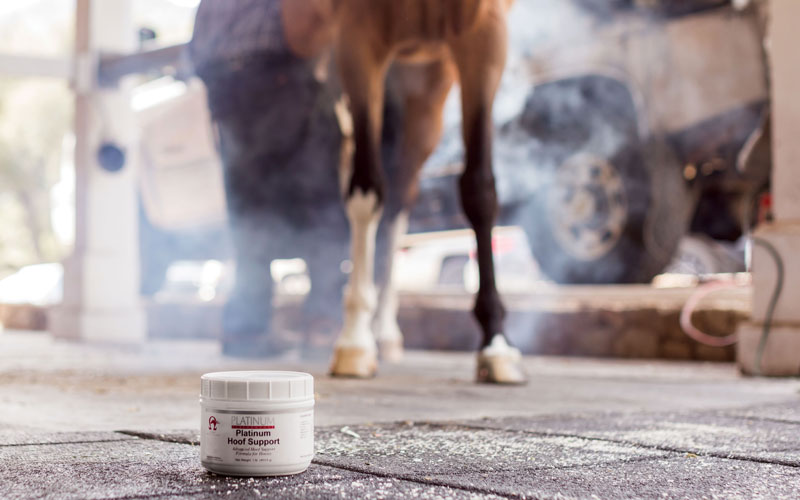
““The most important factors to hoof health are the workload, the environment and the nutrition.”
— Ian Curry, Ian Curry International
Ingredients to Build Healthy Hooves
Biotin
Biotin supplementation has been shown to improve hoof wall strength and increase the rate of hoof growth. Biotin supplementation is particularly recommended for horses fed a high-grain diet and not on pasture.
Copper
In the hoof, copper enables important enzymatic functions required for metabolism in rapidly-dividing cells, such as hoof cells. Copper is involved in disulfide bond formation in keratin and cell envelope proteins.
Zinc
Zinc is present in high concentrations in normal hoof tissue and is critical for a variety of functions, including the normal cell division involved in the growth and repair of the hoof wall. It is vital for the assembly of collagen and intercellular cementing substance.
Methionine
The sulfur-containing amino acids cystine, cysteine and methionine play a key role in the development of the “cellular envelope,” also known as the marginal band, which protects horn cells against protein-degrading enzymes. Methionine is necessary for integrity of the white line and is essential for hoof growth. As a primary constituent of keratin, methionine stimulates strong, healthy hoof growth and is essential to prevent cracked, brittle hooves.
L-lysine
The availability and balance of the amino acids are more important than the general crude protein intake. Both lysine and methionine are essential for hoof growth as they are necessary for producing all body proteins including keratin, an extremely strong, specialized type of skin cell and the major structural protein for the hooves.
Manganese
Manganese is an antioxidant trace mineral that protects the hoof cell membrane from oxidation. This mineral is important to chondroitin sulfate synthesis that’s integral to joint cartilage maintenance and bone matrix formation and repair.
Cobalt
Cobalt is necessary for the synthesis of the vitamin B12 complex, which plays a role in a horse’s amino acid, carbohydrate and fatty acid metabolism, as well as nervous system function.
3. Fats
Fats play a pivotal role in a healthy hoof as they retain natural moisture and pliability of the hoof wall, resist the absorption of water from the environment and prevent bacteria and fungi from entering the hoof horn. Hoof tissue has 3-6% total fat, which works to bind cells together and aids in repelling water. Fatty acids are important nutrients for healthy hooves as they help in connecting hoof horn cells and sustain a permeability barrier. Deficiency of fatty acids can be seen in skin and hoof problems with dry, splitting feet that do not respond well to vitamin/mineral-specific supplements but improve when supplemented with a formula containing essential fatty acids.
4. Vitamins
Several vitamin antioxidants are influential to hoof health including beta carotene (precursor for vitamin A), vitamin C and vitamin E as they offer protection from oxidation at the membrane level. Vitamin A is also necessary for keratin production. Vitamin C is influential in the production of collagen which is incorporated into all connective tissues. Unlike vitamin C which can be synthesized in the intestines of the horse to prevent maintenance deficiencies, beta carotene and vitamin E may require supplementation for horses without access to fresh grass to support hoof health.
5. Minerals
Minerals are needed for virtually every process in the entire body of the horse, and growing, protecting and strengthening hoof tissue is no exception. Providing the requirements needed for maintenance at the particular stage of life the horse is in is extremely important. However, it is also important that minerals are in the correct proportion to each other since they interact with each other and can interfere with the absorption of another if levels are too high or too low.
The macromineral calcium is integral for hoof growth and strength and is involved in the creation of sulfur cross-links between the hoof proteins and in the cohesion of cells to each other and initiates cell envelope formation. If calcium levels are low in the overall diet, supplying extra calcium to meet requirements may positively impact hoof quality, as well as bone quality. Many horses show a noticeable improvement in hoof horn quality when diets are balanced for calcium and phosphorus. Hoof quality suffers dramatically with inadequate levels of zinc or copper. A lack of either zinc or copper can result in slow hoof growth and thin, weak walls. High iron intake, extremely common in horses, can compound the problem as it interferes with absorption of both these minerals. Significant hoof improvement is typical for horses that receive adequate supplementation of zinc and copper. Zinc and copper are not only needed for the hoof itself but also necessary for forming healthy tissue that attaches the outer hoof wall to the living tissue underneath. Oxidative damage to the fats in the hoof structure break the protective seal on the hoof. This causes drying and weakening of the cementing “glue” between the cells.
Hoof quality relies heavily on a dietary component that is made up of energy, protein and amino acids, fats, vitamins, macro and trace minerals. Nutritional changes, including supplementation, influence new growth. Studies have shown that the equine hoof wall takes approximately 9 to 12 months to grow from the coronary band to the weight-bearing surface. Quantifiable hoof changes require time, consistency and patience. Healthy hooves start from within, and the foundation of soundness in the horse is a healthy hoof.
Ask the Farriers:
What Role Does Nutrition Play in the Equine Foot?

Ian Curry
Ian Curry International
“Workload, the environment and the nutrition are the major factors in hoof health. Nutrition plays a huge role. If they’re getting plenty of minerals, you see a better hoof. If the diet isn’t optimal, you can definitely tell in their feet. With the hunters and jumpers here in Florida, I see feet that start to deteriorate from the environment and other issues. The feet fall apart, they just crumble, and we have to figure out how to keep them shod and keep them sound. The diet is really important for this, especially the minerals. The nutrition is not getting to their feet, and adding extra minerals is helpful.”
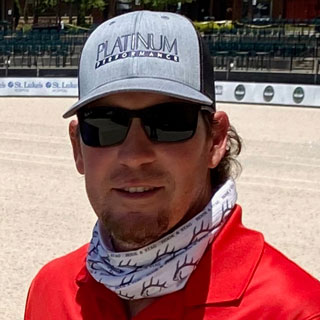
Michael Majors
Majors Farrier Service
“There are two key factors in hoof health. Nutrition plays a key role in hoof health along with cleanliness — of stall, turnout and feet. Nutrition determines the overall health of the horse, particularly in the hoof. A horse with an insufficient nutritional plan can be more susceptible to illness and injury. Just about every horse is lacking in some area of nutrition, so a good supplement is almost mandatory. For horse owners, being consistent with a good nutritional plan and paying close attention to how the horse moves and travels can aid in early detection of changes in the hoof that may need intervention.”

Wesley Meyer
Wes Meyer Horseshoeing
“Nutrition is 100%. All my sport horses down here in Florida, all my show horses, they’re on a hoof supplement. I don’t care how good their feed is, I recommend it as preventative maintenance. I shoe horses up in Michigan every 4 weeks during the summer when they’re up there showing, we go back and forth. When they’re up north, they just thrive. They grow well, and it’s a lot less maintenance for me to cater to them. They come down south, and you can just see how their feet are deficient. The heat and the temperature really affect the horses in general and their feet suffer along with it. We have to make sure they get hoof supplements. It seems like when they come down to this hot climate, the nutrition isn’t reaching their feet as well. They shut down in the heat and they take all their food, all their nutrition, to the major organs and nothing gets to the feet. They might be getting these things in their food but not enough, and that’s when we rely on a hoof supplement.”
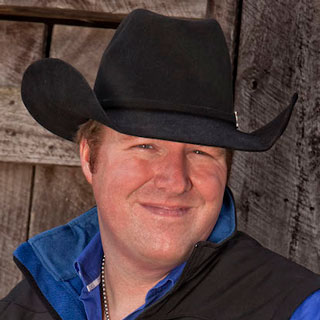
Corey Payne, MS, AAPF I, DVM ('21)
Payne Equine
“Nutrition plays a huge role in hoof health. An appropriate and balanced feeding program is essential for ensuring and maintaining a healthy horse and hoof. For new and healthy hoof growth to occur, known as keratinization, all essential nutrients must be available to the hoof in the proper amounts and proportions. This starts with ensuring that the horse has a well-balanced feeding program regarding the concentrate feed and forage. The proper amount of essential amino acids and other essential nutrients are required for optimal keratinization of hoof wall, which occurs at the coronary band. In addition to the basic nutrient building blocks of protein, carbohydrates and fat, there are several trace minerals that are required for healthy hoof growth and hoof integrity such as zinc, copper, manganese and the vitamin biotin. These nutrients can always be provided through a good balanced supplement if we think that the feed and forage alone is not providing adequate amounts for optimum hoof health. One of the biggest things that I see when people start feeding a hoof supplement is that they get discouraged and stop the supplement when they don’t see immediate results in improved hoof quality. The nutrients we are providing through feed and supplementation are only feeding the keratinocytes at the coronary band, which are the cells that produce hoof wall, not the hoof that we see closest to the ground. It takes anywhere from 9 months to a full year for the hoof being generated by these cells at the coronary band to reach the ground. This is a very slow process. This growth rate is influenced by the age of the horse and season of the year, so it takes a continued supply of these nutrients over a long period of time to ensure that the hoof that ends up near the ground is healthy and strong.”

by Emily Smith, MS,
Platinum Performance®
